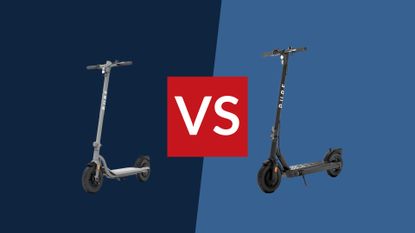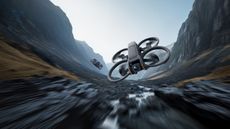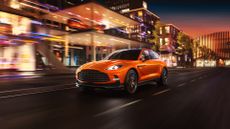What’s the best foldable electric scooter for micro mobility? If you’re after one of the best electric scooters available then you’ve surely come across the Pure Air and the Pure Air Pro. Somerset, UK-based company Pure Electric’s two-wheeled electric scooters are positioned to be a notch above the mass-market, but which one is the best electric scooter?
You might think that the Pure Air Pro is a newer upgrade on the Pure Air, but that’s not actually the case. Appearing in August 2020, the Pure Air is a scaled-down and more affordable version of the Pure Air pro, which launched a few months earlier.
There’s a lot to like about both the Pure Air and the Pure Air Pro, but they have a different appeal; the more affordable Pure Air is one of the best budget electric scooters available and the pricer Pure Air Pro is simply one of the best electric scooters around.
Here’s the ultimate guide to the differences between the Pure Air and the Pure Air Pro so you can make a call on which one is the best electric scooter for you.
Pure Air vs Pure Air Pro: Price
The Pure Air and Pure Air Pro are no longer available, but the 2nd generatioin of each model is. You can find the best prices for the Pure Air (2nd Gen) and Pure Air Pro (2nd Gen) below:
Pure Air vs Pure Air Pro: Design
Given that the Xiaomi M365 more or less invented and popularised the concept of electric scooters in the UK and beyond, it’s no surprise that the Pure Air and Pure Air Pro have a similarly simple design. Available in black or grey, the Pure Air measures 119x116x50 cm while the Pure Air Pro measures 120x115x50 cm.
They both weigh 16.5kg. So physically they’re virtually identical – and relative to other electric scooters available, rather heavy. Like most electric scooters they also fold down, the Pure Air to 51x116x50 cm and the Pure Air Pro to 50x115x50 cm. Again, almost the same size. However, they’re both too heavy to carry more than very short distances.
There are some slight physical differences. Both the Pure Air and the Pure Air Pro include a touchscreen display, but while on the Pure Air Pro it’s positioned on the right-and side of the handlebars, the Pure Air sees it centrally positioned. The Pure Air Pro has rubber handlebar grips while the Pure Air’s are foam.
While most electric scooters claim a ‘splash-proof’ IP54 rating, the Pure Air and the Pure Air Pro goes further to IP65, which makes it more suitable to British weather where heavy rain is always a possibility. It means these electric scooters can be ridden in the rain and through puddles without worry. That’s a good reason to choose an electric scooter from Pure Electric, but it won’t help you choose between the Pure Air and the Pure Air Pro.
However, there is one really big difference between the two that will help you come to a decision.
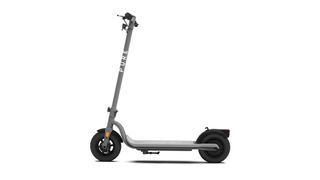
Pure Air vs Pure Air Pro: Features
The Pure Air Pro out-guns the Pure Air where it matters for some, but despite the pricier upgrade being having a larger battery and more powerful motor it’s possible that the Pure Air will suit you just fine.
With a top speed of 15.5 mph/25 kph and a range of 18.5 miles/30 km, the Pure Air uses an electric motor with a power output of 250W. Pay the extra for the Pure Air Pro and you get the same top speed, but an extended range of 22.4 miles/36 km. It also has an electric motor with a power output of 350W.
Both have 10-inch air-filled tyres with pre-installed puncture prevention fluid, which will help reduce one electric scooter riders’ biggest bugbears. If there is a flat tyre, know that the tyre valves are easily accessible. Other safety features include side reflectors, LED headlights and rear lights.
Both will soon come with obligatory Bluetooth-enabled features, with the Pure Electric app for Android and iOS set to launch soon. Displaying a rider’s speed, range, remaining battery, mileage and your own personal CO2 saving (to make you feel good), it will be compatible with both the Pure Air and the Pure Air Pro (make sure you buy the version with Bluetooth).
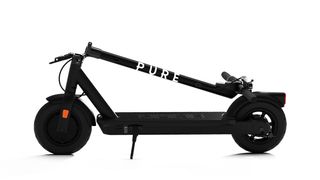
Pure Air vs Pure Air Pro: Performance
The more expensive model’s 350W front-wheel motor delivers great acceleration in urban environments. While the legal the top speed is limited to 15 mph, the extra power is really handy on inclines, bumps, potholes and when carrying heavier loads. Talking of which, while most electric scooters top-out at a 100 kg carrying capacity, the Pure Air and Pure Air Pro can both carry a 120 kg maximum load.
Crucially, both have batteries that take a mere 5.5 hours to recharge. That’s much quicker than most electric scooter batteries, which tend to refuel in about 8 hours.
Pure Air vs Pure Air Pro: Verdict
The Pure Air Pro is a more powerful and version of the Pure Air with a greater range and a greater weight capacity. It’s also got a few minor upgrades such as rubber handlebars. None of that is surprising given the price difference. More important is that the real key characteristic of the Pure Audio Pro – that guaranteed IP65 water resistance for all-season scootering in the UK – is also found on the Pure Air.
So if you’re not concerned about having maximum range, power and capacity, the only slightly more basic abilities of the Pure Air may make it a more suitable choice for you – and help you make a considerable savings.
- Read T3's full Pure Air Pro review
- Read T3's full Pure Air review
- Best electric scooter: top e-scooters for adults
